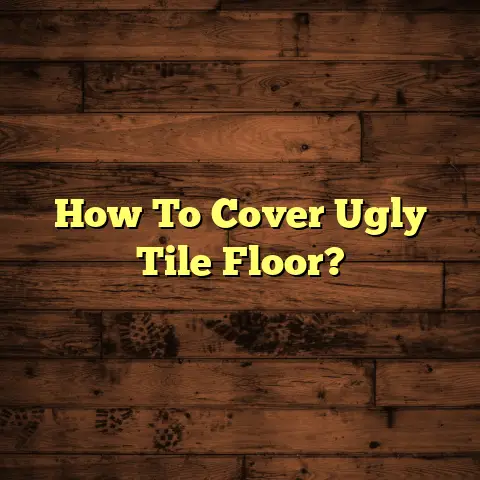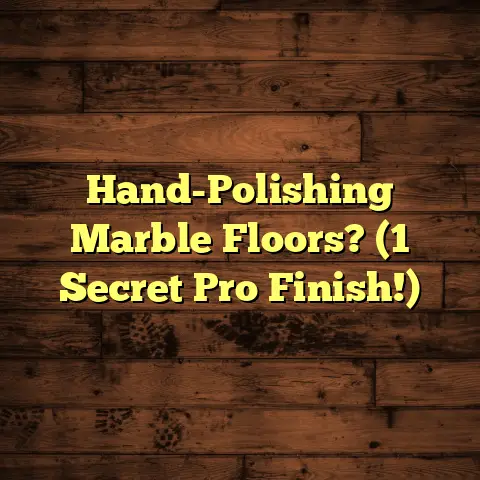White Paint on Wood Floors: How-To (6 Tips!)
How-To (6 Tips!)
And what’s a fantastic way to
brighten up that canvas?
White paint!
It’s amazing how
white paint can completely transform
the look and feel of a room,
making it feel more open,
airy, and modern.
Think of it: a crisp, clean foundation
that complements practically any
decor style.
I’m talking coastal chic,
minimalist modern, farmhouse cozy –
you name it, white floors work.
But before you grab a brush and
start slinging paint, there are a
few things you need to know to
get it right.
Trust me, I’ve seen
it all – from peeling paint to
uneven finishes.
So, let’s dive into my tried-and-true
tips for achieving those stunning
white-painted wood floors you’ve been
dreaming of.
Ready to get started?
Section 1: Preparing for the Project
Okay, so you’re pumped to transform
your floors.
Awesome!
But hold
your horses.
The secret to a
flawless finish?
Preparation, preparation,
preparation.
I can’t stress this enough.
First things first, let’s assess the
condition of your wood floors.
Are
there any major gouges, deep scratches,
or signs of water damage?
These
need to be addressed before you
even think about paint.
Why? Because paint will only accentuate these imperfections, not hide them.
Next, consider the existing finish.
Are your floors varnished, stained,
or sealed?
If so, you’ll likely need
to sand them down to create a
proper surface for the paint to adhere to.
Think of it like this: paint needs
something to “grip” onto.
A smooth,
slick surface won’t cut it.
Cleaning is also crucial.
I recommend
a thorough vacuuming followed by a
good scrub with a wood cleaner.
Avoid anything too harsh that could
damage the wood.
I often use a solution of mild dish soap and water, followed by a rinse with clean water and thorough drying.
Now, let’s talk paint.
Choosing the
right paint is just as important
as prepping the floors.
I always
recommend a high-quality floor paint
specifically designed for wood.
Why?
Because these paints are formulated
to withstand the wear and tear
of foot traffic.
They’re also more
durable and resistant to scratches
and scuffs.
Consider the sheen as well.
A higher
sheen (like semi-gloss or gloss) will
be more durable and easier to clean,
but it will also show imperfections
more easily.
A lower sheen (like
matte or satin) will hide imperfections
better, but it may not be as
durable.
Personally, I often lean towards a
satin finish for a good balance
of durability and aesthetics.
It’s all about finding what works
best for your space and lifestyle.
Finally, think about primer.
Do you
need it?
If your floors are particularly
dark or stained, or if you’re using
a lighter shade of white paint,
primer is essential.
It helps to block the underlying color
and create a uniform surface for
the paint to adhere to.
I typically
use an oil-based primer for the best
results, but latex primers are also
available.
Section 2: Gathering the Right Tools
and Materials
Alright, now that we’ve got the prep
work covered, let’s talk tools.
Having the right tools makes the
job so much easier and helps you
achieve a professional-looking finish.
Here’s my essential list:
Paint: As I mentioned, a high- quality floor paint specifically designed for wood is key.
I’m a big fan of Benjamin Moore’s Advance or Sherwin-Williams’ Emerald Urethane Trim Enamel for durability and a beautiful finish.
(Source: Personal experience and professional recommendations)Primer: If needed, choose an oil-based or latex primer designed for wood.
Kilz is a reliable and readily available option.Brushes and Rollers: Invest in good-quality brushes and rollers.
I prefer angled brushes for cutting in along the edges and a microfiber roller for applying the paint to the main floor area.
Purdy brushes are my go-to.Painter’s Tape: This is your best friend for creating clean lines and protecting baseboards and trim.
3M ScotchBlue Painter’s Tape is a classic for a reason.Sandpaper and/or a Sanding Machine: You’ll need sandpaper for sanding down the floors and potentially a sanding machine for larger areas.
I typically start with 80-grit sandpaper to remove the existing finish and then move to 120-grit for a smoother surface.Drop Cloths and Protective Gear: Protect your furniture and belongings with drop cloths.
And don’t forget gloves and a mask to protect yourself from paint fumes and dust.-
Vacuum Cleaner: A good vacuum cleaner with a hose attachment is essential for removing dust and debris after sanding.
-
Tack Cloths: These are sticky cloths that you use to wipe down the floors after vacuuming to remove any remaining dust particles.
Why are quality tools so important?
Well, think about it this way:
a cheap brush will shed bristles,
leaving them embedded in your paint.
A flimsy roller will leave an uneven
finish.
And low-quality paint
simply won’t last as long.
Investing
in good tools is an investment in
the longevity and beauty of your
floors.
Section 3: The Painting Process
Alright, the moment we’ve been waiting
for!
Let’s get painting.
Remember,
patience is key here.
Don’t rush
the process.
Take your time and
focus on achieving a smooth, even finish.
Step 1: Sanding. This is arguably
the most important step.
You need
to create a slightly rough surface
for the paint to adhere to.
If you’re dealing with a varnished
or sealed floor, you’ll need to
sand it down completely to remove
the existing finish.
I recommend
starting with 80-grit sandpaper
and then moving to 120-grit for
a smoother surface.
For floors that are already in relatively good condition, you may only need to lightly sand them with 120-grit sandpaper to create a “tooth” for the paint to grip onto.
Step 2: Priming (if necessary).
Apply a thin, even coat of primer
using a brush and roller.
Be sure
to follow the manufacturer’s instructions
for drying time.
Step 3: Painting. Now for the fun
part!
Start by “cutting in” along
the edges of the room with a brush.
This means painting a narrow strip
along the baseboards, trim, and
corners.
Then, use a roller to apply the
paint to the main floor area.
Work
in sections and overlap each stroke
slightly to avoid streaks.
Remember to apply the paint in thin,
even coats.
Multiple thin coats are
always better than one thick coat.
Why?
Because thick coats are more
likely to drip, sag, and take longer
to dry.
Technique Tips:
Brush Technique: Hold the brush at a slight angle and use long, smooth strokes.
Avoid pressing down too hard, as this can create brush strokes.Roller Technique: Use a roller extension pole to save your back.
Roll in a “W” pattern and then fill in the gaps.
Overlap each stroke slightly to avoid streaks.Avoiding Drips: Keep an eye out for drips and runs.
If you spot any, immediately smooth them out with a brush or roller.Working in Sections: Divide the room into manageable sections and complete one section at a time.
This will help you maintain a wet edge and avoid lap marks.
Section 4: Finishing Touches
Once you’ve applied the first coat
of paint, resist the urge to immediately
start walking on it!
Allow it to
dry completely according to the
manufacturer’s instructions.
This is crucial for achieving a durable
and long-lasting finish.
I usually
recommend waiting at least 24 hours
between coats.
After the first coat is dry, inspect
the floor for any imperfections.
If you spot any drips, runs, or
uneven areas, lightly sand them
down with fine-grit sandpaper (220-grit)
before applying the second coat.
Apply a second coat of paint using
the same techniques as the first.
Again, be sure to apply it in a
thin, even coat and allow it to
dry completely.
For high-traffic areas, you may want to consider applying a third coat of paint for added durability.
Once the final coat of paint is
completely dry, consider applying
a protective sealant.
This will
help to protect the paint from
scratches, scuffs, and wear and
tear.
I recommend using a water-based polyurethane
sealant specifically designed for
floors.
Apply it in thin, even coats
using a brush or roller.
Section 5: Maintenance and Care
Congratulations!
You’ve successfully
painted your wood floors white.
Now,
it’s time to learn how to keep
them looking beautiful for years
to come.
Here are some tips for maintaining and caring for your painted wood floors:
Cleaning: Sweep or vacuum your floors regularly to remove dust and debris.
For mopping, use a damp mop and a mild soap solution specifically designed for painted surfaces.
Avoid using harsh chemicals or abrasive cleaners, as these can damage the finish.
I recommend using Bona Hardwood Floor Cleaner.Protecting: Place rugs in high- traffic areas to protect the paint from wear and tear.
Use furniture pads under the legs of chairs and tables to prevent scratches.Avoiding: Avoid wearing shoes with sharp heels or cleats on your painted floors.
Also, be careful when moving furniture to avoid scratching the surface.Repairing: If you do get any scratches or chips, you can touch them up with a small amount of paint.
Lightly sand the affected area and then apply a thin coat of paint using a small brush.
Over time, even with the best care,
your painted floors may start to
show signs of wear and tear.
When
this happens, you can either touch
up the affected areas or repaint
the entire floor.
Section 6: Creative Ideas and Inspirations
Now that you know how to paint your wood floors white, let’s talk about some creative ways to use them in your home decor.
Minimalist Modern: White floors are the perfect complement to a minimalist modern aesthetic.
Pair them with clean lines, simple furniture, and a neutral color palette for a sleek and sophisticated look.-
Coastal Chic: Create a breezy, coastal-inspired space by pairing white floors with light blue walls, natural textures, and nautical accents.
-
Farmhouse Cozy: Add a touch of rustic charm to your home with white floors, vintage furniture, and warm, inviting textiles.
-
Bohemian Eclectic: Embrace a bohemian vibe by pairing white floors with colorful rugs, patterned textiles, and eclectic artwork.
The possibilities are endless!
Don’t
be afraid to experiment and find
a style that reflects your personal
taste.
I’ve seen homeowners use stencils to
create unique patterns on their
white floors, like geometric designs
or floral motifs.
Others have used
different shades of white paint to
create a subtle, textured effect.
Ultimately, the goal is to create
a space that you love and that
reflects your personality.
White-
painted wood floors are a versatile
and beautiful foundation that can
help you achieve that goal.
Conclusion:
So, there you have it – my ultimate
guide to painting wood floors white.
It’s a project that requires some
time and effort, but the results
are well worth it.
With a little preparation, the right tools, and a bit of patience, you can transform your floors and create a stunning, personalized space that you’ll love for years to come.
Remember, white paint is like a
magic wand for your floors.
It
can brighten up a dark room, make
a small space feel larger, and create
a clean, modern aesthetic.
So, what are you waiting for?
Grab
your paintbrushes and let’s get
started!
I can’t wait to see what
you create.





